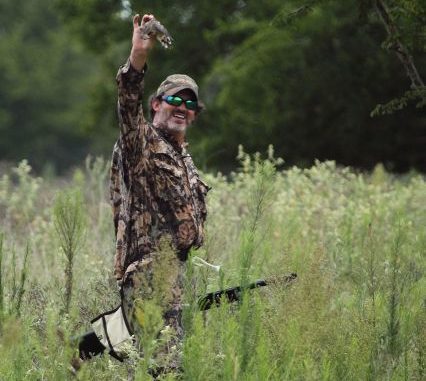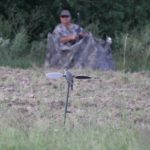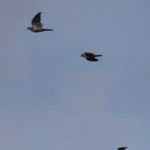
When doves descend on ag fields this month, they will be lucky to make it through the hail of lead. Here are some thoughts on how you can get in on the action.
Nearly forty years ago, I made my first dove hunt near the desert town of Orogrande, New Mexico, while on a six-year stint in the Air Force.
Growing up, my home state of Michigan didn’t have a season. To this day, fickle Michiganders haven’t decided whether or not to join the other 39 states that do hunt dove.
As a result, my northern friends don’t get a chance to enjoy what is a grand tradition for folks here in Louisiana.
Where doves are concerned, I have to say that my days in the desert in the early ’80s spoiled me.
There was open land galore in the form of Bureau of Land Management property, national forests, military reservations, state game areas and the local rancher who just plain didn’t care if you shot dove on his property as long as you didn’t shoot his cows.
Much of the New Mexican landscape remains that way today.
We’d find a stock tank out in the desert, and late in the afternoon set up in a patch of mesquite near the watering hole and wait. Just before sunset, wave after wave of morning doves would come to fetch a drink to wash down the seeds in their crops.
My Antonio Zoli over-and-under’s barrels would run hot until I had a limit of 12 birds just as the sun set on the horizon.
By contrast, 95 percent of Louisiana’s land mass is private and behind locked gates, making it difficult for the average guy to find a place to hunt dove. Back in the ’80s when I was just moving to the Sportsman’s Paradise, that was a tough pill to swallow, since I didn’t know anyone.
And over the years that followed I had pretty much given up on my favorite upland pursuit, evolving into a duck hunter.
Times change with the fall winds that chase the brownish gray birds from the northern regions of the country. And one of the places they eventually wind up during the fall migration is the southwest prairie of the Bayou State.
It was here I received my first invitation to a traditional afternoon opening-day dove shoot, when a good friend sprang for the fee that included lunch and refreshments.
Now I look forward to my annual dove hunt, using it as a tune-up to the early teal season. And though the hunt differs from my desert excursions of yesterday, it’s still wing shooting at its finest, with lightning-fast, dip-diving doves.
Every beat of their wings seems to be a new aerial combat maneuver, much like those F-15s I worked on back in the day out in the desert.
Rice farmers in the southwest part of the state, like Rick Moore of Moore Farms in Welch, have the property and migrating birds. For a reasonable day rate, hunters can book a dove hunt, where basically they have access to a manipulated field all day.
Hunts, depending on the weather and stage of migration, can range from just above average to stellar.
“We’ll offer day hunts again this year for $100,” Moore said. “We had been at $75 for years and years, but the cost of things have just gone up so much (that) we finally had to increase the price.
The cost is usually worth is because of the groceries that normally draw in masses of birds.
“Last year we had a phenomenal opening day and killed somewhere over 600 birds,” Moore said. “It’s hard to get an accurate count with folks coming and going.
“Hopefully, we’ll have plenty of dove and it’ll be that way again this year.”
By comparison, an average one-round greens fee, depending on the golf course, will run you between $50 to $60. The local golf course in Patterson where I live, the Atchafalaya at Idlewild, is $68 on Saturday and Sundays.
Toss in a golf cart rental and lunch in the clubhouse, a day off the links to hunt dove might just save you a few bucks in early September.
The hunt Moore puts on during opening weekend is an all-day affair that includes lunch and plenty of cold drinks before going back out to the field in the event that you didn’t fill your limit that morning.
Like Moore, Josh Johnson of Triple J. Charters in Lake Charles offers dove hunts on an agricultural field he manages south of Interstate 10 near Lacassine.
Johnson said the region where his field is located has a little bit of everything that draws doves, making it an ideal location to hunt.
“This area is so good,” Johnson said. “It’s farmland where you have soybeans and rice. Plus, there’s plenty of water with Lacassine Bayou just down the road and a lot of canals close by. There’s also roosting ground for them with some big trees around the area.
“You just have everything they need: food, water and roosting. And there’s just a bunch of birds as a result.”
I counted 15 other hunters who shared Johnson’s field last fall on opening day. Everyone spread out safe distances from each other, but I did notice most of the hunters hid where they could find some shade along the tree line.
It wasn’t long before doves began flying into the field. They didn’t pour in, but sporadically came in pairs and small groups of three to six — sometimes more.
The birds obviously wanted to feed in Johnson’s field.
“We hunt both millet and natural seeds like goat weed,” Johnson said. “During the early season the goat weed is just starting to come up, but by the second split of dove season it’s really popping. During the first split your millet is all headed out, and all I do is bush hog some lanes to knock some seeds on the ground. I’ll also have some plowed ground showing. So, I have a little of both during the season.”
All of the hunters seemed to get their shots at birds over the course of the afternoon. Not everyone limited — myself includedf. But I was satisfied with the seven birds I brought home.
What’s more, from what I could tell I was probably one of if not the low man, so we had a good day in the field.
There were some stellar shots made on passing birds flying at high rates of speed, dipping and diving like incoming fighter jets avoiding anti-aircraft artillery.
Dove-hunting opportunity is on the increase for those who prefer hunting public land. The Louisiana Department of Wildlife and Fisheries is doing its part securing properties.
“One thing that we always try to do is provide as many public dove-hunting opportunities as possible,” LDWF’s Jeff Duguay said. “We do this through planting dove fields on wildlife management areas and leasing land from farmers for opening day of dove season.
“Opening day in 2013, we leased three fields for a total of 702 acres. Six hundred four hunters utilized these fields; they bagged 1,102 doves.”
One of the best WMAs to dove hunt is the little 160-acre Elbow Slough WMA in southeastern Rapides Parish near the intersection of state Highways 1 and 3170.
The WMA is strictly dove-hunted on Saturdays, Sundays and Wednesdays, with opening weekend hunts by lottery only.
In 2013, 42 hunters killed 524 doves for an opening-day average of 12.47 birds per person.
The following day, 21 hunters harvested another 171 doves for a 8.14-bird average. The first day the WMA was open to the general public, 55 hunters bagged 278 dove for a 5.05-bird-per-person average, according to Jeff Johnson, LDWF biologist supervisor for the Gulf Coastal Plain North WMAs.
“Those are pretty good numbers for public land hunts,” LDWF’s Johnson said. “Elbow Slough WMA generally has some of the best — if not the best — dove hunting on public land in Louisiana. And over the long term … I’d feel safe saying it has the highest average harvests per hunter.
“Our big crowds are the first two days of the first split, which is why we had to go to lottery hunt for those days.”
Jeff Johnson said his agency places most of its dove-hunting focus managing for opening weekend of dove season. However, little additional work in terms of mowing or manipulating is done for the second split, as other WMA needs take precedent by then.
The Louisiana Department of Wildlife and Fisheries annually publishes on its website their public dove field leases and WMA opportunities along with the rules pertaining to the hunts.
On my opening day hunt while talking with Josh Johnson, he pointed out that birds coming in as singles and doubles were mainly local birds — the bigger flocks were migrating birds.
Dove hunting has a long-standing tradition throughout Louisiana, especially on opening day. And depending on whether you feel like springing for a day hunt with a few friends and family or just trying out one of the LDWF’s public dove areas, there’s ample opportunity to try your hand at some dip diving birds in the bayou state.







